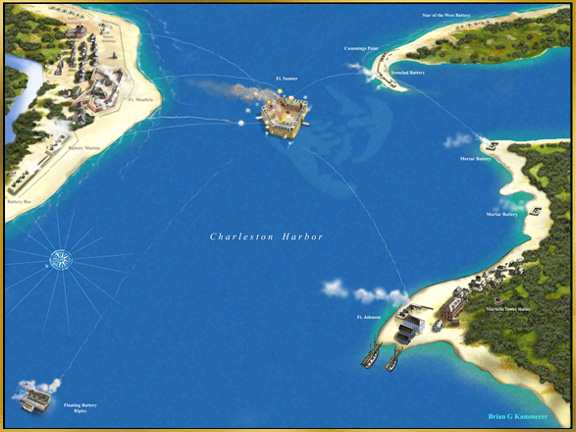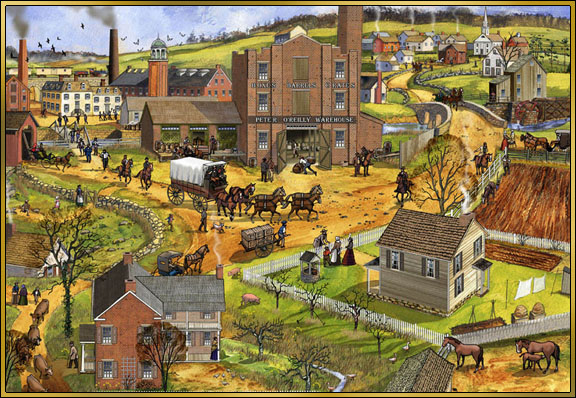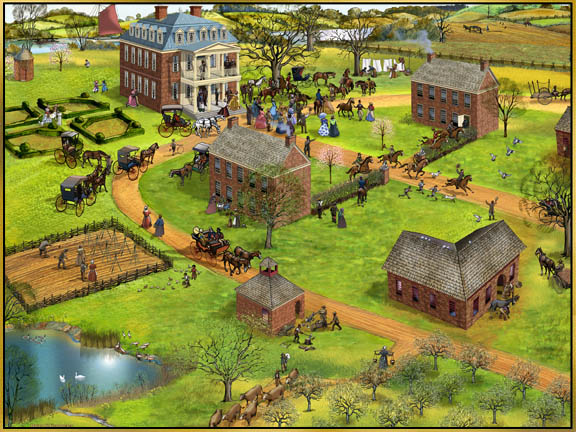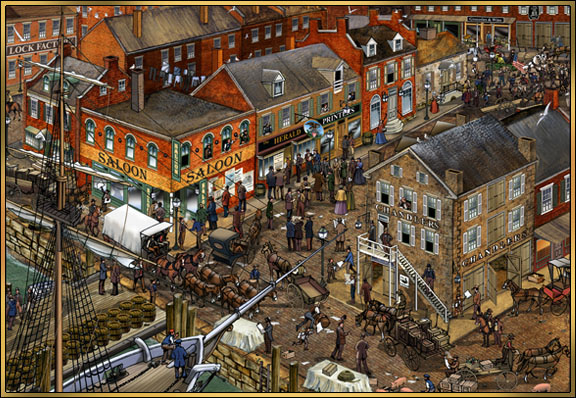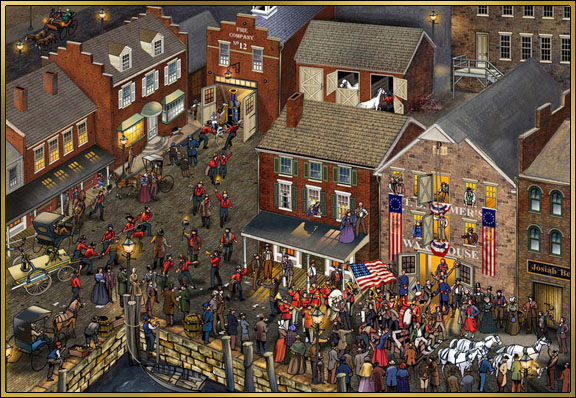
 |

![]()
Prelude to War

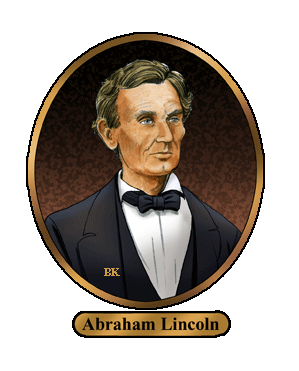 Before the first shot was fired upon Ft. Sumter, tumultuous events had led up to the secession of South Carolina. The issue of slavery had split the Democratic Party in Charleston and the rift widened upon the Republican nomination of Lincoln in Chicago for President. With the election of Abraham Lincoln the Ordinance of Secession was signed and South Carolina departed from the Union. On Dec. 20, 1860 delegates from six other Southern states convened to discuss proposals for a new government. In February of 1861 Jefferson Davis was elected president of this new Confederacy along with other leaders. The Virginians were reluctant to quit theUnion and willing to compromise and remained neutral.
Before the first shot was fired upon Ft. Sumter, tumultuous events had led up to the secession of South Carolina. The issue of slavery had split the Democratic Party in Charleston and the rift widened upon the Republican nomination of Lincoln in Chicago for President. With the election of Abraham Lincoln the Ordinance of Secession was signed and South Carolina departed from the Union. On Dec. 20, 1860 delegates from six other Southern states convened to discuss proposals for a new government. In February of 1861 Jefferson Davis was elected president of this new Confederacy along with other leaders. The Virginians were reluctant to quit theUnion and willing to compromise and remained neutral.
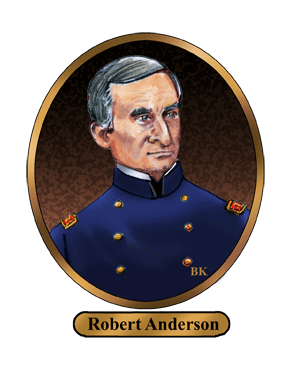
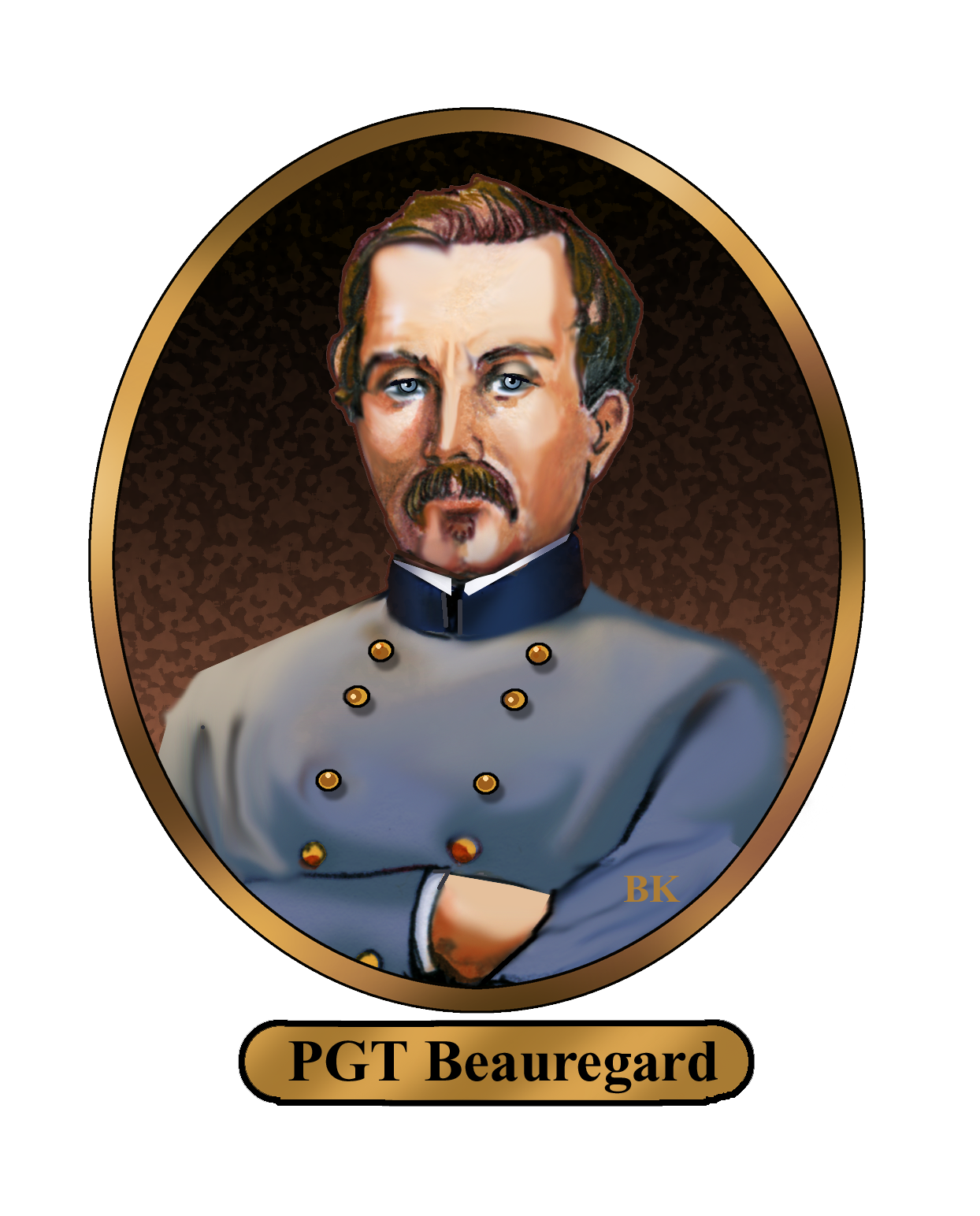
Charleston Harbor was ringed with forts. Some log embrasures were built for the young nations’ defense during the American Revolution and later brick and mortar forts for national defense in the late 1700’s and early years of 1800. By Christmas of 1860 enthusiasm for soldiering had become a craze in Charleston. Brig. Gen. P.G.T. Beauregard, former superintendant of the U.S. Military Academy at West Point and competent engineer and artillery expert, was summoned by Davis to take command of the Charleston defenses of the newly formed Confederacy. Demands that all Federal property be surrendered to the newly constituted republic of South Carolina had been refused by Washington.
An undermanned Union garrison was stationed at Fort Moultrie on Sullivan’s Island. The fort according to the senior company commander Capt. Abner Doubleday was no more than a sea battery and virtually indefensible from the rear. Cottages had been built right up to the walls of the fort while drifting sand from wind and storm surges created dunes that rose to the height of the parapets in some sections negating proper defense from an assault by hostile forces.
Maj. Robert Anderson, a Southern born officer transferred the Union forces the more defensible yet incomplete Fort Sumter during the evening of Dec. 26. Before leaving Fort Moultrie they spiked the guns and burned the gun carriages.
On Jan. 9, 1861 an unarmed packet steamer named The Star of the West was secretly sent from Washington packed with U.S. soldiers to reinforce the troops at Sumter. Information about the mission was leaked to the press. The Citadel cadets, manning the 24lb guns at the sand dunned embrasures on Morris Island, were under orders to fire upon any strange vessel which attempted to pass up the channel. The U.S. ensign flying from her gaff and foretruck made no impression upon the cadets and the command to “Fire” was given. A geyser of water and the echo of a boom announced the warning shot across her bow . As the steamer came closer the guns of Fort Moultrie took up the cadence and began to fire upon the Star of the West. Anderson held his fire. Capt. McGowan decided not to take the chance. The Star of the West turned to starboard and raced back down the channel out of range. Fort Sumter was now isolated on its own.
Click on Ft. Moultrie, Sumter, Cummings Point and Ft. Johnson for closeup views.
Charleston Harbor, April 12, 1861
Major Anderson is informed by note that an attack will commence in one hour if orders to evacuate Fort Sumter are not obeyed. At 4:30 in the predawn darkness of April 12, 1861 a shell exploded over Fort Sumter. It was 10" shell fired from the mortar battery at Fort Johnson that briefly illuminated the brick casements of the fort sitting alone in the harbor. The 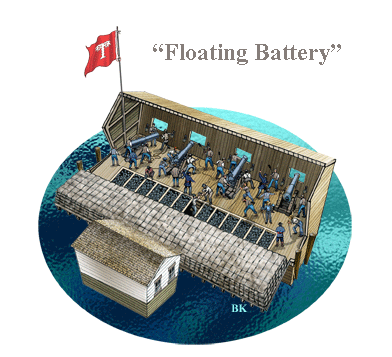 signal shell commenced the bombardment of Sumter. Anderson, under orders to fight back if attacked, held his fire until daylight because the garrison though well stocked with shot and powder was short of cartridge bags. Gen. Beauregard the consummate mathematician estimated that he had sufficient powder and ammunition for a 48 hour shelling. His orders were that the guns were to fire in a counterclockwise circle around the fort with the spacing of two minutes between each shot. A floating battery, a barge of pine and palmetto logs strapped with railroad iron, fired their four 32 lb guns through the portholes of its armored gabled roof. The guns of Moultrie resounded each in their turn. The Iron Battery on Cumming Point with three 32 lb. Columbiads answered from across the channel aiming at the rear of the fort and sally port. The artillery crews in Sumter, lacking the right equipment for proper sighting because they had mistakenly left them behind when Fort Moultrie was abandoned, had little luck in damaging the floating battery and the well entrenched ironclad batteries that fired upon them. Eventually they turned their focus upon the closer Fort Moultrie with better results. Hot shot and bursting shells set fires in the wooden buildings of Fort Sumter. Each time a structure was set ablaze the men were able to extinguish the blaze within a short time. The bombardment continued throughout the day, slackened by the Confederates and stopped entirely by Anderson during the night.
signal shell commenced the bombardment of Sumter. Anderson, under orders to fight back if attacked, held his fire until daylight because the garrison though well stocked with shot and powder was short of cartridge bags. Gen. Beauregard the consummate mathematician estimated that he had sufficient powder and ammunition for a 48 hour shelling. His orders were that the guns were to fire in a counterclockwise circle around the fort with the spacing of two minutes between each shot. A floating battery, a barge of pine and palmetto logs strapped with railroad iron, fired their four 32 lb guns through the portholes of its armored gabled roof. The guns of Moultrie resounded each in their turn. The Iron Battery on Cumming Point with three 32 lb. Columbiads answered from across the channel aiming at the rear of the fort and sally port. The artillery crews in Sumter, lacking the right equipment for proper sighting because they had mistakenly left them behind when Fort Moultrie was abandoned, had little luck in damaging the floating battery and the well entrenched ironclad batteries that fired upon them. Eventually they turned their focus upon the closer Fort Moultrie with better results. Hot shot and bursting shells set fires in the wooden buildings of Fort Sumter. Each time a structure was set ablaze the men were able to extinguish the blaze within a short time. The bombardment continued throughout the day, slackened by the Confederates and stopped entirely by Anderson during the night.
April 12, 1861-North
The North in the spring of 1861 was prosperous and interconnected with its many roads, canals and railroads. Agriculture loomed large in American culture especially in the export trade. The planting of wheat and corn has begun on the many large and small farms that dotted the land. Most parts of the country produced their own meat & dairy products, fruit and other perishables. As the country had expanded, canals supplanted roads for moving bulky items such as timber, products and farm produce. Rail transportation would prove to be more efficient. The steam locomotive could move heavier loads faster. Winter did not halt shipments by rail as canals were by freezing weather. The rise of railroads allowed New Englanders to sell their goods anywhere in the country and farmers in the Midwest could in turn sell their grain to the ever growing cities of the East coast and even Europe. The controversy over slavery challenged this unity but had not of yet destroyed it. The bombardment of Fort Sumter in the early morning hours of April 12th, 1861 would forever change all of that. The reverberation of those guns would signal the commencement of hostilities and a bloody civil war that would last four years and tear the country apart.

Click on Sumter, Spectators, Battery East, Palmetto Guards and Battery alley to see CU views.
East Battery
The citizens of Charleston came out in droves to watch the spectacular bombardment. Business men, laborers, townsfolk and ladies in hoop skirts and dainty parasols thronged the seawall, boats, ships and wharves to cheer the cannonade. Families and friends gathered atop their homes and mansions to watch the show. Children thought this was a grand event having never known the sight and sound of battle. Anderson had given strict orders not to fire upon the city so the populace had little to fear. Their thoughts were with their young sons and fathers who were firing the guns and praying for their deliverance. On the morning of the 13th a Confederate hot shot set fire to the officers’ quarter and the blaze spread to the barracks. Flames leaped above the parapets and clouds of smoke curled above the fort. The Confederate gunners redoubled their efforts sensing victory was imminent. The heavy smoke now hindered the defenders from returning fire. They were finding it hard to breathe with kerchiefs bound over their faces. Sumter’s fire slackened and then eventually ceased. At around 1:30 pm a Confederate shot brought Sumter’s shot torn flag fluttering to the ground. A Confederate officer was sent under a flag of truce to approach the fort with terms of surrender. Anderson agreed to talk. At 7:30 pm the engagement was officially at an end when the terms were accepted by both sides. Fort Sumter was finally in Confederate hands. The bombardment had lasted for 34 hours with over 3,000 shot and shells fired and not a man was killed. This was a bloodless start to a soon to be very sanguine war.
On the 14th, Anderson and his men leave the fort and proceed northward, by sea, after a formal surrender ceremony. The flag they lowered at Fort Sumter would be again raised and displayed in Union Square on the 20th of April in New York City. Major Robert Anderson would be the featured speaker and rally many a man to Lincolns call for volunteers.

April 13th 1861-North
As the news of the shelling of Fort Sumter in Charleston Harbor was telegraphed and voiced throughout the land, work came to a standstill. Men poured into the streets and byways as factories and mills heard the cry of war. In 1860 about 4 million Americans were of foreign birth, roughly the same as the number of slaves. Slave labor was not a suitable method for factory work and was discarded as an institution. It simply did not pay. Starting around the 1830's, Irish & German immigrants had flooded into America fleeing famine in Ireland and political unrest in Germany. Immigrants were nearly all poor and many totally illiterate. The Irish remained in the Eastern cities to become day laborers and factory workers but the Germans tended to move westward to cities like Milwaukee and Cincinnati. Other Germans & many Scandinavians took up farming in the rich unsettled lands in the frontier and upper Middle West. Northerners saw themselves as part of a unified nation not divided like the European continent they had left recently or many years earlier. America was a land of opportunity and skillful equality, a meritocracy where one could become wealthy if he so desired. Economic opportunities were abundant in the North. Slavery was a moral wrong to most Northerners and needed to be abolished. The only problem was that the New England textile industry was totally reliant on the unbroken supply of Southern cotton and the South was a society based on large plantations and slave labor. The South also bought many of the goods produced in the North like wagons, salt pork, machinery and ironware. This news of war and disunion by their fellow countrymen was unsettling.

Click on the formal garden, departing crowd, young men riding & smokehouse to view closeup views.
News of Sumter Reaches Virginia
News of Fort Sumter’s surrender reached Richmond late on Saturday of April 13. Crowds poured into the street in jubilation. A hand sewn flag unfurled to reveal the seven-starred, three –striped flag of the Confederate States of America. The jaunty tune of Dixie was heard as word of Sumter spread like wildfire.I have used the peaceful, productive and orderly Shirley Plantation as my setting for Virginia’s response to the sound of the guns in Charleston Harbor. This settlement was Virginia's first plantation (1613) and one of the first economic engines of the new world. Along the James River there were many tide water planters and homes of successful men. I envisioned bridled restraint until after Sunday prayer service. Their sons, well educated and seasoned to horse and firearms, would be eager to join with their friends in celebratory revelry. Work did not stop on the plantation. The chores still needed to be finished. The coming war would changes things but not just yet.
On Monday April 15 Lincoln called for 75,000 Militia to put down the rebellion in the South. Virginia still part of the Union would refuse to send troops and vote 85-55 for secession April 17th. Sic Semper Tyrannous was the states motto.
Declaration of War and Lincoln's Call for Troops
Fort Sumter fell on Sunday April 14th. Major Anderson and the proud garrison marched out as the band played "Yankee Doodle" and a 50-gun salute preceded the lowering of Old Glory. One cannon discharged prematurely, killing a gunner and mortally wounding another. Theirs were the only lives lost along with that of a horse. Next day, Lincoln called out 75,000 militia. These state units would serve 90 days to suppress those that would oppose the laws of the United States. Virginia, North Carolina, Tennessee, and Arkansas refused to furnish men "for making war on the South," and promptly seceded from the Union. Later Lincoln would order a blockade of Southern ports. This "War of words," that had so plagued the land for many years had finally become real. The street rang with the call of "WAR" as newsboys hawked special editions as new information filtered in from Washington and beyond. Northerners were outraged by the recent events and as in all wars, "Politics and pocketbooks" were the topic of conversation. An angry mob even stormed the offices of the pro-Southern New York Herald forcing its publisher James Gordon Bennett to display the Stars and Stripes as a sign of loyalty to the Union and to prevent the burning of his offices and equipment.

Click on the Balcony orator, steamboat, crowd at intersection & train to see closeup views.
Southern Call to Arms
It was "WAR". The scene was repeated from city to town all across the South as Leaders spoke of loyalty and bands played patriotic tunes to rouse the fire within the hearts of Southern men. Torchlight parades winding through neighborhoods or along river fronts with bands and banners leading the way. The people were in a state of intoxication and insanity. To the youth there was great excitement and adventure in the air. This was going to be a great adventure and free them from the boring lives they considered their existence to be. Glory was to be won like the patriots of old. Death in battle was not even contemplated. Not all rejoiced with the prospect of war. Husbands and sons would be swept up into the ranks leaving hearth and home for weeks, months, maybe forever. Life in the coming years would never be the same.

Night Rally for Volunteers
Patriotism and martial ardor now swept the land. Citizens gathered in the streets of cities and towns to voice their outrage and to hear rousing speeches by political leaders. Local brass bands filled the air with music as flags were waved and hung from windows to show loyalty and support. Northerners for the most part were stunned and angered by the attack upon the American flag. In Boston the church bells tolled all day long. The Local Militias responded to Lincoln's call by gathering at their local armories to get the equipment needed for their departure and the defense of Washington. Some units of City Fire fighters gathered to enlist as companies with their Chiefs as their new Captains. These were heady times. These units called themselves various names to identify their uniqueness like the Fire Zouaves. Reason and compromise had failed. The men that were answering the call to arms would be the ones to now decide the issue. Lincoln truly had hoped that bloodshed might be avoided. He believed the South to been truly misguided in their rebellion. Lincoln's pledge at his inauguration to preserve the Union on the other hand placed him in the unattractive role of aggressor if he was to crush this insurrection with a force of arms. President Davis of the Southern Confederacy did not believe that Northern men in the hundreds of thousands would fight for national union, abolition and a host of other platitudes they proclaimed sacred. Northerners now had to consider what the American Republic meant to them and this "democratic experiment" that the writers of the Declaration of Independence had proclaimed in 1776 under the threat of treason and death.

![]()
